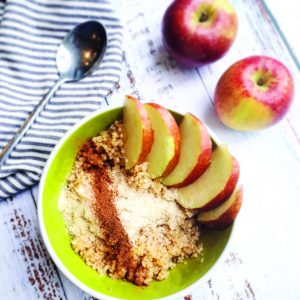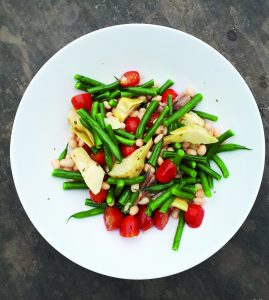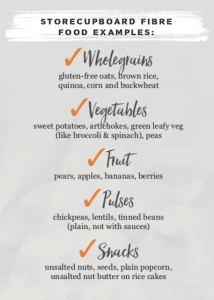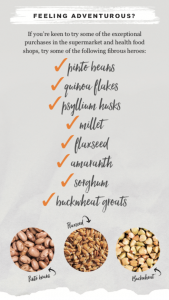Are you getting enough fibre? (And what to do about it if you’re not) Ali Walsh finds out…
Exactly one year ago, I was wearing a hospital gown and about to undergo general anaesthetic. Why? How can I put this delicately? Let’s just say some skin in a certain area kept splitting and the doctors thought poking around and giving me a jab of Botox would sort things out. And it did. For 10 weeks. Then the splitting started again.

Fast forward a few months and you may remember me cooing about a gut reset I did.
I crowed over the good things that came of it, little realising there was one more problem it would solve. Yep, the splitting ceased, and all because I’d increased the amount of fibre in my diet. (If you’re still in the dark, just think about digestive transit and how when something soft is released, it’s far less likely to cause tearing.) TMI? I do apologise. But I feel it’s necessary as a precursor to my feelings about fibre. It only recently occurred to me my problems began after I was diagnosed with coeliac disease.
Before you start panicking, coeliac disease itself wasn’t to blame. It was my gluten-free diet instead. Cutting out wheat, barley and rye meant I was no longer eating cereals like Weetabix and Shredded Wheat or chomping on muesli and wholegrain sandwiches, and I hadn’t replaced them with fibrous alternatives.
It’s not just me. It turns out adults aren’t getting the recommended daily intake of 30g. Instead, it’s more like 18g. And if you’re not having bottom issues and wondering why it matters, there’s a heck of a lot of reasons other than mine. Short-term, getting enough fibre eases constipation, prevents haemorrhoids, aids digestion and helps you feel less hungry. Long-term, the NHS states it lowers the risk of heart disease, stroke, type 2 diabetes and bowel cancer.

So here’s my focus. Fibre. In all its glory. And plenty of it.
So what is fibre, exactly?
Coeliac UK tells us ‘fibre is the part of plants that passes through the body without being absorbed.’
What foods contain fibre?
Let’s see if you already know. Here’s a quick quiz: which of the following foods contain the most fibre?
(a) Jacket potato
(b) Chia seeds
(c) A rare steak
Take a moment to consider your options. What do your family think? What’s your gut instinct?
I’ll give you a clue: it’s not the steak. The answer is the chia seeds (34g per 100g). The jacket potato doesn’t do badly at around 4g (medium-sized, as long as you eat the skin). The steak has nothing.
But getting fibre can be tricky if you need to avoid gluten. Firstly, you need to find out where you’re going wrong, and a good way to do it is to keep a food and drink diary. Include everything, be honest and you’re off to a great start. (You will be honest, won’t you?!)

After a week of writing everything down, you’ve probably spotted some patterns already. Now consult the fibre chart above.
How many fibrous foods are you eating? (N.B. I’ll give you a heads-up: apart from the gluten-free bread, there’s not much fibre in many gluten-free alternatives.)
Whatever your conclusions at this point, now’s a good time to get some professional advice.
I consulted Anna Mapson of Goodness Me Nutrition for some helpful suggestions. She’s the registered nutritional therapist I went to for my gut reset so I know and trust her well. Her specialty is helping people feel balanced, well-nourished and energised.

So what are the basics?
Storecupboard fibre food examples:
✔️ Wholegrains: Gluten-free oats, Brown rice, Quinoa, Corn and Buckwheat
✔️ Vegetables: Sweet potatoes, Artichokes, Green leafy veg (like broccoli & spinach), Peas
✔️ Fruit: Pears, Apples, Bananas, Berries
✔️ Pulses: Chickpeas, Lentils, Tinned beans (plain, not with sauces)
✔️ Snacks: Unsalted nuts, Seeds, Plain popcorn, Unsalted nut butter on rice cakes

Anna’s tips
Anna says including more gluten-free wholegrains in your diet will help you feel fuller for longer. She warns of the perils of eating fibre-free gluten-free alternatives (like gluten-free cakes, pasta and biscuits). Not only are they likely to have little nutritional benefit, they’ll also stop you from having space for fibrous foods. She also recommends getting 5 different fruit and veg a day, eating the skins and then bulking meals out with pulses.
Anna’s put together a 2-day meal plan, showing how you can use the foods from the cupboard to make delicious meals.
Read the Two Day Fibre Plan
Anna’s aubergine and chickpea curry
Ingredients
- 1 onion, peeled
- 3 garlic cloves, peeled
- 1 pepper (any colour), chopped
- 400 g (1 tin) tomatoes
- 1 tsp tomato puree
- a pinch of salt
- 1/2 tsp cumin
- 1/2 tsp chilli powder
- 1 small chopped aubergine
- 1 tin chickpeas, drained
- a handful of coriander
Instructions
-
Chop the onion and garlic. Sauté in a small amount of water and a pinch of salt until soft.
-
Add the pepper, tomatoes, tomato purée and cumin (and chilli if using) and cook until the veg is soft. When ready, blend until smooth.
-
Add the aubergine and chickpeas. Cook until the aubergine is soft.
-
Add a handful of chopped coriander and stir.
-
Serve with brown rice or quinoa, and more coriander to garnish.
Fibrous puddings
If you’ve got a sweet craving, Anna recommends eating stewed apple with a handful of raisins and a pinch of cinnamon or eating a piece of fruit such as a pear.
Things to watch out for
Before you dive head-first into a high fibre diet, there are a couple of things worth noting.
❌ Don’t suddenly increase your fibre intake or you may experience gas, bloating and diarrhoea.
✔️Remedy: gradually increase your fibre intake week by week.
❌ Don’t go overboard with fibre. You know the mantra – too much of a good thing – so make sure you observe the RDA (Recommended Daily Amount).
❌ Keep your snacks sugar-free if possible, avoiding dried fruit. The NHS website states, “because dried fruit is sticky, it can increase the risk of tooth decay”.
✔️ Remedy: dried fruit should be eaten as part of a meal, not as a snack.

Feeling adventurous?
If you’re keen to try some of the exceptional purchases in the supermarket and health food shops, try some of the following fibrous heroes:
✔️ pinto beans
✔️ quinoa flakes
✔️psyllium husks
✔️ millet
✔️ flaxseed
✔️ amaranth
✔️ sorghum
✔️ buckwheat groats
Slowly does it
If this all seems a little overwhelming, I’ve realised that making small changes can make a big difference long-term. I’ve swapped regular gluten-free pasta for brown rice pasta (Doves Farm Freee brown rice spaghetti is particularly good). I’ve started adding foods like red lentils and raw spinach to curries and stews. Not only that, but breakfast tastes infinitely better with some toasted flaked almonds and lunch is super-speedy with a ready-made dahl (of which I make an enormous pan on a Sunday afternoon). As for snacks, popcorn’s fairly difficult to buy without added no-nos so buying it in kernels and popping it in a saucepan’s proved incredibly cheap (and desperately exciting for the children).
The only major error I’ve made was trusting green lentil lasagne sheets. I bought them thinking I was going to produce the best Italian bake ever. It wasn’t. But that’s the fun in trying out new recipes. That, and reading about someone else’s calamities so you don’t make them yourself. So best of luck in your fibrous journey – may there be many delicious meals to come!
Further reading: Eat Yourself Healthy by Dr Megan Rossi. Recipe books by Deliciously Ella
Note: always check with your doctor before starting a new diet, particularly if you have a history of bowel issues, including IBS.
Sources: NHS, Coeliac UK & Anna Mapson, nutritionist (www.goodnessme-nutrition.com)
